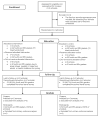Bicycle Trains, Cycling, and Physical Activity: A Pilot Cluster RCT
- PMID: 28668251
- PMCID: PMC5894119
- DOI: 10.1016/j.amepre.2017.05.001
Bicycle Trains, Cycling, and Physical Activity: A Pilot Cluster RCT
Abstract
Introduction: Increasing children's cycling to school and physical activity are national health goals. The objective was to conduct an RCT of a bicycle train program to assess impact on students' school travel mode and moderate-to-vigorous physical activity (MVPA).
Study design: Pilot cluster RCT with randomization at the school level and N=54 participants.
Setting/participants: Fourth-fifth graders from four public schools serving low-income families in Seattle, WA in 2014 with analyses in 2015-2016. All participants were provided and fitted with bicycles, safety equipment (helmets, locks, and lights), and a 2- to 3-hour bicycle safety course.
Intervention: The intervention was a bicycle train offered daily (i.e., students volunteered to cycle with study staff to and from school).
Main outcome measures: Time 1 assessments occurred prior to randomization. Time 2 assessments occurred after 3-5 weeks of the intervention (i.e., during Weeks 4-6 of the intervention period). The primary outcome was the percentage of daily commutes to school by cycling measured by validated survey. MVPA, measured by accelerometry and GPS units and processed by machine learning algorithms, was a secondary outcome.
Results: For two separate adjusted repeated measures linear mixed effects models in which students (N=54) were nested within schools (N=4), intervention participants had: (1) an absolute increase in mean percentage of daily commutes by cycling of 44.9%, (95% CI=26.8, 63.0) and (2) an increase in mean MVPA of 21.6 minutes/day, (95% CI=8.7, 34.6) from Time 1 to Time 2 compared with controls.
Conclusions: A pilot bicycle train intervention increased cycling to school and daily MVPA in the short term among diverse, inner-city elementary school students. The bicycle train intervention appears promising and warrants further experimental trials among large, diverse samples with longer follow-up.
Trial registration: This study is registered at www.clinicaltrials.gov NCT02006186.
Copyright © 2017 American Journal of Preventive Medicine. Published by Elsevier Inc. All rights reserved.
References
-
- McDonald NC, Brown AL, Marchetti LM, Pedroso MS. U.S. School Travel, 2009: An Assessment of Trends. Am J Prev Med. 2011;41(2):146–151. https://doi.org/10.1016/j.amepre.2011.04.006. - DOI - PubMed
-
- Ogden CL, Carroll MD, Kit BK, Flegal KM. Prevalence of childhood and adult obesity in the United States, 2011-2012. JAMA. 2014;311(8):806–814. https://doi.org/10.1001/jama.2014.732. - DOI - PMC - PubMed
-
- Troiano RP, Berrigan D, Dodd KW, Masse LC, Tilert T, McDowell M. Physical activity in the United States measured by accelerometer. Med Sci Sports Exerc. 2008;40(1):181–188. https://doi.org/10.1249/mss.0b013e31815a51b3. - DOI - PubMed
-
- Skinner AC, Perrin EM, Skelton JA. Prevalence of obesity and severe obesity in U.S. children, 1999–2014. Obesity. 2016;24(5):1116–1123. https://doi.org/10.1002/oby.21497. - DOI - PubMed
-
- Mendoza JA, Liu Y. Active commuting to elementary school and adiposity: an observational study. Child Obes. 2014;10(1):34–41. https://doi.org/10.1089/chi.2013.0133. - DOI - PMC - PubMed
Publication types
MeSH terms
Associated data
Grants and funding
LinkOut - more resources
Full Text Sources
Other Literature Sources
Medical


